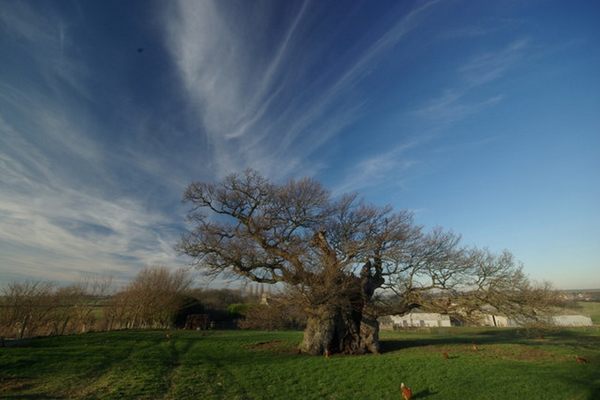About
In the small village of Much Marcle, an ancient tree stands beside St. Bartholomew’s Church. Though the church dates back to the 13th century, the tree is even older—it has a few centuries on the building. The yew’s hollow trunk is vast enough to accommodate several people standing inside it. The yew’s longevity and grandeur have earned it recognition as one of Britain’s most important trees.
Yews have long been associated with churchyards in Britain, particularly because of their symbolic links to eternity and immortality. In ancient times, they were considered sacred, with some yews believed to have been planted on the sites of pre-Christian pagan worship. In the case of the Much Marcle yew, it is thought that the tree could have been standing long before Christianity took root in England, and may have been a focal point for spiritual activities.
The yew tree's extraordinary age means it has been a silent witness to much of Britain’s history. Its hollow trunk now forms an impressive natural chamber, likely developed after the central wood decayed over the centuries. Despite this decay, the tree continues to thrive and is considered a living monument. The hollow core has been carefully preserved, allowing visitors to step inside, where the tree’s age becomes even more palpable.
Beyond its symbolic and historical significance, the Much Marcle Yew is also ecologically important. Yews are long-living trees, and their resilience makes them a key feature in Britain’s ancient landscapes. The tree supports a diverse ecosystem, providing habitat for various species of wildlife, and its hardy nature exemplifies the yew’s importance in both cultural and environmental heritage.
Related Tags
Know Before You Go
The ancient yew is located in the churchyard of St. Bartholomew’s Church in the village of Much Marcle, Herefordshire. The village is easily accessible by road and is located in a picturesque part of the English countryside, near the Malvern Hills.
The yew tree is easily accessible from the churchyard. Make sure to step inside the hollow trunk to fully appreciate the tree's scale and age.
As with any ancient tree, it is important to respect its fragile nature. Avoid touching or climbing on the tree to ensure that it can be enjoyed by future generations.
Published
October 30, 2024
Sources
- https://www.herefordtimes.com/news/20128237.ancient-herefordshire-tree-part-jubilee-celebrations/
- https://www.rossgazette.com/news/yew-wont-believe-it-ancient-tree-is-listed-in-royal-project-548399
- https://www.ancient-yew.org/yew_tree_database/much-marcle/
- https://www.hereford.anglican.org/news/ancient-yew-in-much-marcle-included-in-the-70-ancient-trees--the-queens-green-canopy.php




























